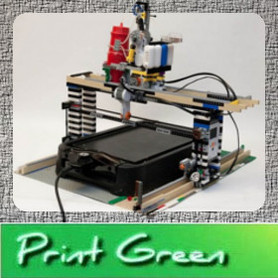 LEGO PancakeBot by: Miguel Valenzuela On PrintGreen's previous post, we had a toaster printer that serves a hot and fresh breakfast bread with a twist, a bread toaster that mimics an inkjet printer that creates a perfectly toasted meal for everyone. Also, it was featured on the said post the Zuse Toaster printer that lets you print small images on the bread before it rolls out of the toaster.
Now, we will be featuring another amazing way of serving your daily breakfast meal through 3D printing technology. Serving toasted breads everyday can make your morning a bit boring, so why not prepare a different meal for once. Pancakes are tasty meals that you can serve not just for breakfast, even for lunch, dinner and serve as a good stomach filler. Preparing it can be time consuming, but a good and appetizing meal can't be serve in just a snap.
Have you tried making pancakes that are so tasty yet their not too appetizing to eat cause of the shape? Well here's the solution to your pancake shaping problem, the LEGO PancakeBot printer.
With its perfect mechanism, and through the PancakeBot's X and Y axis, rows of perfectly round shape pancakes are serve nice and easy. Design by Miguel Valenzuela, his creation intends to serve tasty and round silver dollar shape pancakes for everyone.
The system is controlled by three axis. The X and Y axis control the location of the pancakes, while the C axis controls the amount of batter dispensed from a ketchup bottle controlled by a dual pneumatic system. The LEGO arms hold up the motor and batter dispenser unit, which straddles a heated pan. As the LEGO arms move along the heated tray, two rows of bite-sized pancakes are squeezed out and begin to cook.
That's a very interesting and amazing way of making our daily pancakes. It seems that printing technology has becoming more convenient not just for the print industry but also for our daily meal preparation needs. The 3D printing technology can produce several kinds of fully functional materials, and it wouldn't be surprising to see kitchen utensils on the market that were made through 3D printing technology. This technology uses metals, woods and plastic components to produce certain materials, unlike conventional printers that uses eco-friendly toner cartridges and ink cartridges in order to create printouts. The LEGO PancakeBot is certainly a delicious and amazingly yummy innovation. Though it still needs some human intervention to flip the pancakes and cook both sides. The invention was planned to be a part of the 2013 Maker Faire in the Bay Area this May.
Have you seen a printer that instead of making printouts, toasted breads are ejecting from it? It's not very common for us to see new and peculiar equipments, sometimes there are few concepts that are just too good to be true. Even a bread toaster isn't something too exciting to see, but knowing that it features a naive design and an unusual concept, then that makes you curious. An unusual application of printer concept has been applied to one of our easy breakfast meal helper, a bread toaster that mimics an inkjet printer. Designed by Othmar Muhlebach and was named Printer Toaster, with the goal to renovate a somehow usual tool into something that kicks a new way of creating a hot and fresh toasted bread. Consider it as the modernize way of toasting wherein you just have to wait for the bread to drop on the lower tray, nicely done, hot and ready. The design won second prize at the Berner Design Awards. If you're familiar on how an inkjet printer or a fax machine shoots a paper sheet, then watching the Printer Toaster will surely amaze you the same way. Now if you still can't get enough, how about while waiting for some of the breads to get toasted from the Printer Toaster, make some or rather burn some nice images onto your bread. How is it possible? Meet the Zuse Toaster, it can burn an image with at least 12 x 12 pixel in size. The said printer can be re-programmed so users can create a random image printout in a loaf of bread. Literally put a smile on every bread you serve and have a fun breakfast with your family and friends. What I'm partly hoping is that, it would be better if this Printer Toaster can be equipped with real cartridges wherein instead of inks, users can put jams of different flavors as well as butter. Also, why not transformed a laser type printer to something like the Printer Toaster, it can probably toast your bread and create an image all at the same time. While we can't afford to buy either of the two unique printer, don't even try disassembling your personal printers just to have one. Instead practice green printing to cut down your printer expense and help save the environment as well, by using eco-friendly toner cartridges and ink cartridges on your printers.
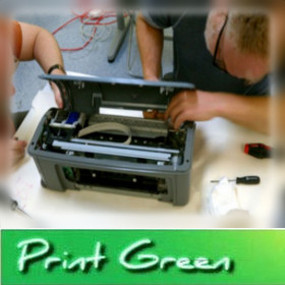 Photo Credit : Instructables BioPrinter Bioprinting as an emerging technology, has gone through a lot of innovations and development that lead to its specific goal of achieving to develop new human tissues and organs. Through hard works and research done on bioprinters, full organs were produced and used by many which create a huge shift on their life. If we will define it, Bioprinting or tissue engineering, is the process the produces organs via a printer that feeds biological materials. An inkjet printer is used as the machine, but instead of ink, cells are deposited on a surface layer by layer, thus an organ has been produced. 3D printer nowadays are being modified to produce the same output, however the success isn't that much. Leaning to his own ingenuity, Patrik, one of the genius member of Instructables, modified an HP inkjet printer, and to his success he was able to transform that abandoned machine into a working DIY Bioprinter. For the complete information about Patrik's DIY Bioprinter, you may refer on the link here. Hacking an old inkjet printer isn't something new to hear, but the fact that it was transformed into a bioprinter is an amazing reason to give credits to this man. Patrik and his team work with the inkjet printer by undressing it first, disassembling the components and covers, as well as reconstructing a new wire system for the paper handling mechanism. After checking if all the buttons are still working fine after all the alterations and modifications inside the printer, next thing they do is prepare the cartridges for a dissecting project. Since it's the printer uses inkjet technology, therefore the project requires inkjet cartridges, unless someone might take the challenge modifying a laser type printer, so there would be a bigger container such as a toner cartridge that can be filled with more biological materials. For printer users who practice green printing, consider opting for eco-friendly toner cartridges and ink cartridges for all your printing needs. They open the cartridges that will be used and tried to fill it with biological materials. Making sure that even though they'll be using new cartridges, they make sure that it's been free from clog and residues, neither no holes, by rinsing each cartridges with distilled or deionized water. Then running a few test print to see if the cartridges and the printer synchronously work together. With their first test print, the team printed arabinose over a half filter paper - placed on an agarose plate that lights up under UV light. To their success, they were able to print a BioCurious eyeball logo. Perhaps their project still needs some refining process to make it work as a fully functional BioPrinter.
LED lights are indeed environment friendly, aside from the fact that they are now commonly used to replace fluorescent light bulbs in order to cut down one's electricity bill as well as reducing negative impacts on the environment. These tiny little pieces of nature caring light emitting diodes are not just use for energy conservation but also for everyone's amusement. A starry starry night to imagine, a romantic glittering place to spend calmness and let yourself be amazed of the twinkling spectacle that LED lights can bring you. The Galleri ROM in Olso, Norway, hangs a hundred strings of floating LED lights that feature about 8,064 pieces of tiny luminous bulb gleaming inside the gallery. The exhibition was named Submergence, designed by Squidsoup, an international group of artists, researchers and designers (UK/NO/NZ) working with digital and interactive media experiences. The gallery will exhibit Submergence from January 17 till February 17, 2013. Inside the gallery, while enjoying the spectacle, passing through the lights triggers a reaction that detects any presence from the surrounding area, creating an audiovisual display that can range from tranquil to hectic. While being encapsulated by these thousand points of light, each bulb pulsates and in a synchronous pattern the light intensity increases, altering the perspective view of the guest passing through it — which tends to confuse the guests and let them lose track of where they are heading inside the dark gallery. As Inhabitat explained, "The piece morphs from darkness to a myriad of colors, sometimes slowly, and sometimes at an energetic frequency, causing further spatial confusion. The light installation transforms from hazy rain-like violet to gauzy orange, alarming red, and other colors that evoke a feeling of calm or anxiety" Each transition is accompanied by a soundtrack that varies depending on the light pattern that is being display, from totally dark to brilliant colors, slowly then gradually changing to rapid variation of color with accompanying energetic soundtrack that sometimes determine the visitors mood. Submergence was designed " to create a work that would evoke a virtual world through sound, light and space, controllable by each visitor." You see, these environment friendly little piece of technology doesn't end up with just a sole purpose, it can also be utilize to inspire and amuse people through art. There are thousands of innovative materials that can be transform into artwork pieces, it's just that no one haven't got the idea to do it. PrintGreen have already featured some designs that use printer cartridges, turning these eco-friendly toner cartridges into art exhibits and other inspiring art pieces.
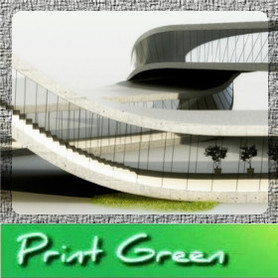 Since the emergence of 3D printing technology, various products created through the said technology were introduced in the market. Conventional manufacturing alone will not be enough to produce this new innovations, and without 3D printing, there are only small chances to be considered and it wouldn't suffice to produce what 3D printing can actually made in just a small span of time. Aside from the considerably small fraction of time that 3D printing takes in order to create an actual output. It can also be used to generate something that is made from eco-friendly materials. In addition to these unbelievable facts, there are researches who have been working on such plan to print an entire frame of a house in just a matter of day. It may sound absurd and unbelievable, but with Janjaap Ruijssenaars, principal of Universe Architecture based in Amsterdam, building the world's first 3D-printed house is something reachable. The concept includes printing out several pieces of 6x9 meters sized frame for the house using the D-Shape 3D printer, to assemble a Mobius strip-shaped house structure. The frame will be using sand and binder, which will be filled or coated with concrete and fiberclass to be able to create a sturdy, flexible and solid two-story building. Ruijssenaars explained the design's origin as, "It was a house in Ireland, the location on the coast is so beautiful that we want the design to reflect the nature." A landscape with an endless, no beginning neither no end design of a house, that's simply how someone would describe this incredible structure. A house that reflects the nature, quite interesting and also intriguing. Although it's called a house, it seems that this two-story structure is just too open literally to live there. But you can still furnish it with couch and seats that suits the concept and designed of the house. It was the collaboration of these two genius people, Janjaap Ruijssenaars and Rinus Roelofs, an artist and mathematician, with the intention to create a continuous movement through a residential space and out onto the surrounding landscape. The initial plan to build a house was actually to designed it for the biennial European architecture competition, and it is expected to be completed in 2014. Though it seems enjoyable to have a rest house like this, with the touch of technology and environment friendliness, this concept will soon become a hit. Since not everyone can't afford to have one of this, and that's given, you can instead purchase or utilize house products that features both the latest functionality and being environment friendly, like LED lights, or even eco-friendly toner cartridges and recycled papers for your printing needs.
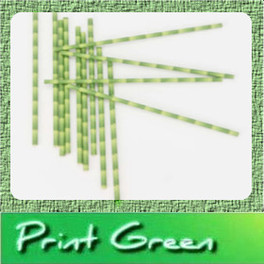 Straw materials are typically made out of plastic components, one good example would be drinking straws, which we often use to sip and enjoy the beverages we drink everyday. Though we don't get to use drinking straws everyday, like with coffee, you don't have to use a straw to drink it unless it's an ice coffee, nonetheless you can use a straw. There are other straw products aside from the one we use to sip a cold beverage. But instead of enumerating those, more than anything else, we should be talking about the material these products were made. Plastic, such a material used to produce different products, yet it tends to leave negative impacts on the environment. Although there were innovations that changed the industry by developing alternative materials from which we can substitute to plastic use. Through those inventions, the use of plastic materials have been reduced over the past years. Substituted by environment friendly, degradable materials that can be utilize as an alternative consumable in place of plastic. As an addition to those plastic alternative materials, here's the Birch and Bamboo Paper Straws that let you experience the way you get used to drink your beverages while being eco-friendly at the same time. It has been described as, "Eco-friendly straws that are made of paper, and have been wax-coated. The unique birch and, bamboo wood patterns have been created using a soy-based ink. These paper straws are a fantastic green alternative to the mainstream plastic variety that are often harmful to the environment."Helping the environment while having fun drinking with a unique straw, what a great way to enjoy your beverages. And to have a more greener life style, try using recycled products and consumables as your alternative daily supplies. Include on your list these eco-friendly toner cartridges and ink cartridges as your printer consumables for a greener and better way of printing.
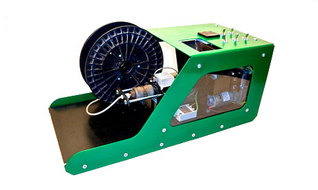 Photo Credit : Kickstarter It's been several months since 3D printing technology became available to the masses, more affordable, convenient, compact and improved versions have been developed for the consumers to utilize. The way consumer goods were fabricated was transform and became more customizable, enhanced and of course easy, but still the products sturdiness and quality remain. Although we can purchase a machine that can produce three-dimensional products and stuffs for us to either use personally or for whatever purpose we wanted, it's just a one time expense we're talking about here. Let's not forget the point that as 3D printer user, you should also consider the cost of maintaining the machine as well the supplies it requires to run. And that particular 3D printer consumable is the plastic filament, which is typically costly and yes a bit of hard to find. For those who are not aware of how much would it cost to buy a plastic filament for 3D printers, well it will cost about $50 or more to purchase a single spool of it. Fortunately, for those who find it a troublesome to replace their printer's filament, here is a great solution that will put an end to your problem. The Filabot, " a machine that allows anyone to make their own 3D printing substrate from old recyclables sitting in the bin." Invented by Tyler McNaney, a genius student from Vermont Technical College in Randolph, United States. Tyler's invention which was funded by Kickstarter, is a compact machine that can turn waste plastic material into a usable filament for 3D printing. Filabot, with its 12 x 12 x 24 dimension, can powerfully grind and melt, then eject the material out of its small recycling-plant-like housing. From an actual test, a single milk container and a detergent bottle can actually be enough to produce an 8 feet long plastic filament for your 3D printer. There's a coil heating element inside this terribly small machine, it varies the temperature to accommodate different types of plastic material. It's been said that the final model of Filabot will feature a tip that can be adjusted to the desired filament diameter. Now if you're wondering if it's out in the market, then McNaney is currently working on it, to produce a batch of Filabot machines to sustain the first wave of orders. For Kickstarter backers, you can get this machine for about $350. When will it be launch to the public, that's a question they can only answer so better check their website for updates. If you've got a lot of plastic waste in your business, then this machine is a business opportunity for you. Make those stream of plastic waste material turn into 3D printer filaments and sell it to the market, that sounds real money. You get a business, plus helping reduce environmental impacts, that's just too awesome. Recycled materials are less cheaper but still sturdy, just like those eco-friendly toner cartridges and ink cartridges, alternatively reliable for your printing needs.
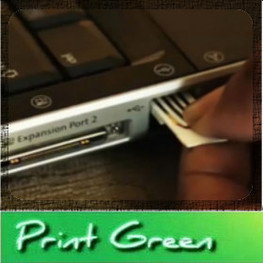 Technology, aside from the fact that it comes with some environmental impacts, it also brought some innovations that led to a few advantages. One of which is the traditional way of using paper materials to keep a copy of files or documents, we then changed it and adapt to the industry advancement through utilizing mobile devices like smartphones and tablets to store our files and documents. Thus, we reduce the amount of paper used to store information and files. Though having said that, it doesn't mean we completely eliminate the use and purpose of paper materials in the digital world. In fact, intelliPaper, a business company that provides products in the data sharing consumer industry, has found a brilliant and extremely surprising way of transforming a tiny piece of paper into a fully functional storage device, specifically the one we called USB drives. One main reason they came up with this invention is cut down the huge waves of e-waste which as we all know, heading to the landfills and contaminates the surrounding environment. If you're wondering how this clever piece of USB technology was developed then here's how, intelliPaper embedded a silicon chip between the layers of paper, laminate those layers, then printed conductive USB traces onto the paper which connect to the main chip. Surprisingly and merely unbelievable, the finished paper USB drive can be embedded into any type of paper product. Although there are micro USB drives like the ones from Verbatim, Buffalo, SanDisk and many more, one thing you should know is that, they're are typically coated of plastic. When the product reached the end of its useful life, just pull out the electronic strip inside and then you can just tossed the paper material right into the bin. Using this device, one thing is for sure, you maximize the usefulness of the paper material you utilize from using it. We've been trying to come up with more ways to reduce our paper usage, and this invention will definitely top the list. You can also practice paper less printing to save on your regular printing expense, or try using eco-friendly toner cartridges and ink cartridges for your printer to save more.
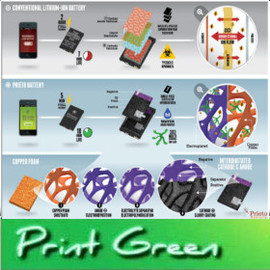 Batteries are intended to supply a small amount of energy for handy devices like our mobile phones. Though it may seem so small to consider doing a research to enhance this teensy device, it's an essential component that almost all devices require in order to operate. Amy Prieto, a Chemistry professor at Colorado State University, have seen the vital importance of a small battery and so she started the Prieto Battery Company that created a three-dimensional battery that is built with a core of copper foam. As it may seems, the project is still in the beginning stages of development. Prieto's hard works on developing this particular 3D foam battery technology could lead to the emergence of high-capacity batteries than can contain energy two times the usual amount it can hold, plus reducing the time needed to fully charge it in as fast as five minutes. There are considerably advance rechargeable batteries in the market that can power the latest smartphones and mobile devices. But they are way too expensive that adds up on the overall cost of the mobile unit, and they actually lose charge in a very short time that users need to recharge the device for about 2-3hours more likely. But there's something we should be worrying more, and that is the fact that these batteries even though they're small in size can also harm the environment with the planet-killing toxins they contain. Amy Prieto have thought, " It’s inexcusable that while our devices have become more sophisticated, our batteries have remained virtually the same for over one hundred years."”It’s just like a sponge, you could think about,” Prieto told Marketplace.org. “Then we paint all the inside spaces with the different materials that you need for the battery. So the ions can go in many different directions, but they don’t have to go very far. So, that’s what I mean by a three-dimensional battery.”They integrated nanowire or copper foam substrate, but both can handle higher power and energy densities than any conventional lithium-ion battery in the market. What's more highly noted from this technology is that these batteries are manufactured using non-toxic chemicals. The said technology has also increase the traditional 500 cycles into an incredible number of 5000 cycles, which extends the life of a battery before it gets wasted and disposed. It is truly an innovation that will change the way we use batteries and also all the devices that needs it. In addition to its promising progress, we should be grateful that here comes another new technology yet never became a threat to the environment. It seems that we're more likely close to reducing e-waste materials in different industries. Noted that now, there are recycled materials like eco-friendly toner cartridges and printer consumables in the market which also reduce carbon footprint. And it's really good to hear about inventions and developments that reduces environment impact.
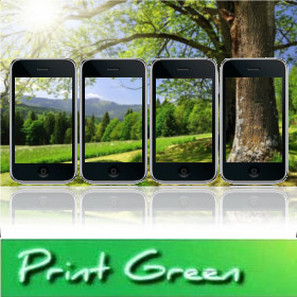 We've been accustomed to the changes and innovations that technology offer us yearly. Such a fast-phased industry that upgrades and phased out several units and machines for a very short time. Advantages come along with the competition between manufacturers, and that's good for the consumers. Let's cite the smartphone industry as an example, in this category there are a lot of big names that manufacture high-end phones from which we splurge ourselves spending our hard-earned money purchasing the latest mobile phone in the market. Now with the competition, there goes the added features, exclusive services, unique functionality, as well as price drops and bargains which we love the most. Talking about bargains, Apple has been working on creating an even more affordable version of iPhone for those millions of users who dreamt of having such an exquisite device but incapable of purchasing one as of the moment, considering its market price. To be able to create a cost-friendly model of the said device, Apple plans to use partial components from recycled materials, particularly those disused or old iPhone handsets. Certain changes to its shell casing will also be applied, as it will probably be using a cheaper polycarbonate plastic outer shell instead of the ultralight hard shell aluminum housing that the recent models were built with. It is allegedly expected to drop a market value of about $99 from its costly price before of $149.Apple just like the other manufacturers that experienced a drop in sales, they are hoping that through this way it will certainly pull back what has been lost from their recent sales. With the emergence of competitive mobile devices from rival companies, a fluctuation in the market causes Apple Inc. to lose its position as the top brand of smart phone in the mobile industry. One distinct reason that this happened is that, there are smartphones now in the market that are much capable of what iOS mobile devices can provide, plus they're far more affordable compared to iPhone's price. Thus pushing the Apple Inc. to create an affordable lower-end smartphone for the masses. This drastic measure, perhaps considered 'in the works', will result to Apple taking a step forward to become more environment-friendly. Using recycled materials, and switching the aluminum casing into cheaper polycarbonate plastic, means a lot to the environment. Since disused or defective iPhone models will be used for this project, it will certainly help reduce the e-waste we accumulate yearly. Having it produced through recycled materials doesn't mean it's a cheap device to consider. Still it holds the name of Apple, so rest assured of its quality and performance remains more than enough, but will somehow be reduce. Besides, recycled materials are more sturdy and can perform way better than its original counterparts. One good example are these eco-friendly toner cartridges and ink cartridges, they are made from recycled materials as well but provides the same quality as the original ones.
|








 RSS Feed
RSS Feed